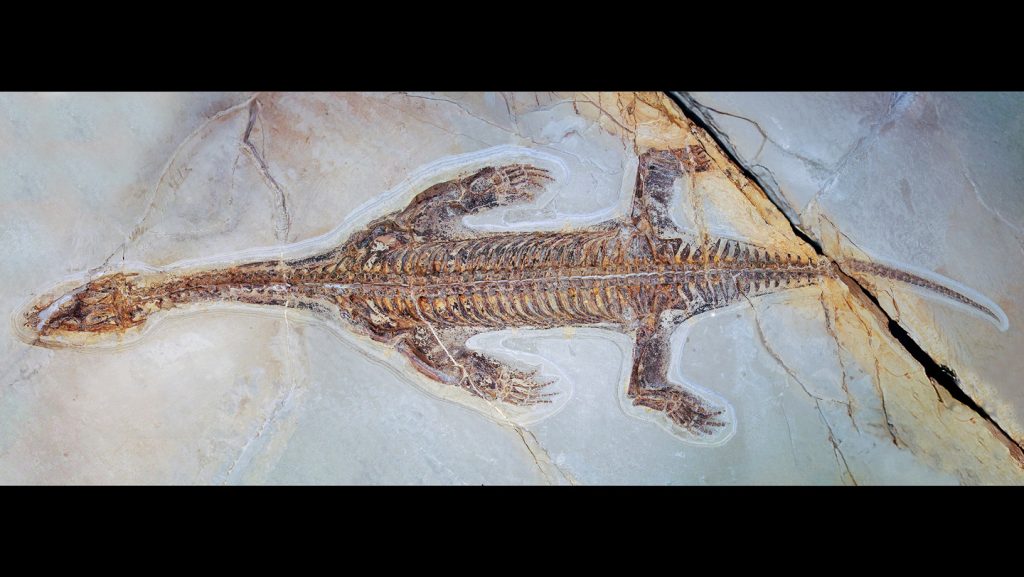Ancient Swimming Reptile Reveals Secrets Through Fossilized Skin
In a remarkable paleontological discovery, researchers have gained unprecedented insights into the lifestyle and adaptations of an ancient marine reptile that swam Earth’s oceans 240 million years ago. The exceptionally preserved fossil of Lariosaurus valceresii, recently unveiled in the Swiss Journal of Palaeontology, offers a rare glimpse into the early evolution of aquatic reptiles and their adaptation to marine environments. What makes this specimen truly extraordinary is the preservation of its skin and scales – the first such example for this type of creature – allowing scientists to reconstruct not just its skeleton, but how it actually appeared and moved through ancient seas.
The significance of this discovery cannot be overstated, as noted by paleontologist Sven Sachs of Germany’s Natural History Museum in Bielefeld: “Fossilized soft tissue is rarely preserved in early aquatic reptiles, but here it is so complete that the body outlines are visible and even the pattern of the skin and some of the muscles can be reconstructed.” This remarkable preservation quality provides crucial evidence about how these creatures, which evolved shortly after Earth’s most devastating mass extinction, adapted to life underwater and eventually gave rise to the iconic long-necked plesiosaurs that dominated Mesozoic oceans.
The fossil emerged from Monte San Giorgio, a UNESCO World Heritage Site straddling the Swiss-Italian border in the Alps. This location represents what was once a tropical lagoon in the aftermath of the Permian mass extinction, which had wiped out approximately 90 percent of marine life and 70 percent of land vertebrates about 252 million years ago. According to Silvio Renesto from the University of Insubria in Italy, “Reptiles thrived in the seas very soon after the crisis.” The ecological void created by this catastrophic event provided ample opportunity for reptiles to colonize marine environments with little competition and abundant food resources, leading to a radiation of new species adapted to aquatic lifestyles.
What made Monte San Giorgio’s ancient environment particularly special for fossil preservation was its unique conditions: poor water circulation combined with bacterial mats that produced hardening minerals created low-oxygen, chemical-rich waters. These factors occasionally allowed for the exceptional preservation of soft tissues when animals died and sank to the lagoon floor. Scavengers and decomposers that would normally consume such tissues were largely absent in this oxygen-poor environment, allowing researchers today to examine details of these ancient creatures that would otherwise be lost to time.
The research team employed sophisticated techniques including high-resolution photography, precise measurements, and scanning electron microscopy to analyze the fossil’s chemical composition and physical structure. Their findings have overturned previous assumptions about how Lariosaurus moved through water. Rather than having hands fully embedded within flippers as previously thought, the fossil clearly shows partially webbed hands and feet with exposed digits. The preserved skin also revealed that, unlike its plesiosaur descendants which had scales only on their limbs, Lariosaurus had scales covering much of its body. Perhaps most fascinating was evidence of “extremely robust” musculature in the forearms, providing crucial clues about its swimming technique.
This newfound evidence points to a swimming style more akin to modern seals than crocodiles. Miguel Marx, a paleontologist at Lund University not involved with the study, explains: “It is clear that this species was using its limbs to propel itself,” rowing its arms rather than using a powerful tail for propulsion. This insight helps scientists understand the evolutionary pathway toward the distinctive swimming method later perfected by plesiosaurs, which used flipper-like limbs for “underwater flying.” As Renesto notes, the discovery emphasizes that limbed locomotion was more important than other swimming methods in these early marine reptiles, representing a crucial step in their aquatic adaptation.
The exceptional preservation of this specimen offers a window into the distant past that bones alone cannot provide. As Marx eloquently states, “Bones don’t really give us a clear idea of what ancient animals would have looked like when alive like fossilized tissues do, and that’s why they are so precious.” Through this extraordinary fossil, we can now better visualize how these pioneering marine reptiles looked, moved, and thrived in the recovering oceans of the early Triassic period, filling ecological niches left vacant by the greatest mass extinction in Earth’s history and setting the evolutionary stage for the diverse marine reptiles that would dominate the seas for millions of years to come.


